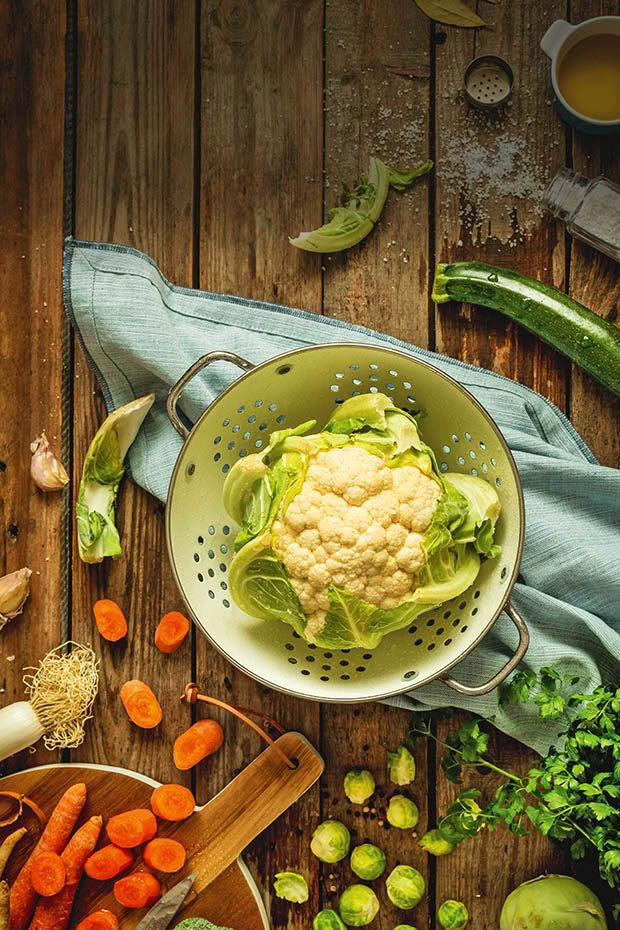The delicious power of cauliflower

No boiling is needed – ever. How to get the best taste and texture from cauliflower.
Words: Jenny Garing
I have a serious addiction to roast cauliflower florets, eaten as is or in a salad, soup, pie, or tart.
As a child of the 1970s and 80s, the cauliflower I ate was either boiled or steamed, covered in cheese sauce.
Boiling doesn’t bring out the best of cauliflower. And why would you do it when roasting it creates a nutty, sweet umami taste with great texture. The crispy bits on the edges are the best part.
Roasting a whole cauliflower covered in spices or turmeric has become quite a trend and looks impressive when served. Roasting or frying thick slices of cauliflower – sometimes called ‘steak’ on vegan menus – is also popular.

Best of all, you can grow varieties from traditional white to bright purple or the most incredible turmeric yellow ‘cheddar’.
We used to make these recipes when I ran the Ground Café and Deli in Lyttelton, back before the 2011 earthquake. I still get rave reviews when I make the Sicilian cauliflower salad when I do catering work.
The creamy cauliflower soup includes a secret trick taught to me by Flic, the former head chef at Ground, which keeps it gluten-free, dairy-free, even vegan, with a creamy, nutty flavour. It’s also highly adaptable with different toppings creating quite different eating experiences.
4 WAYS TO TAKE CAULIFLOWER TO THE NEXT LEVEL

1. Roast it whole. Whole roasted cauliflower takes on any flavour and looks beautiful. It can be as simple as rubbing with herbs and oil, a sauce, or a pre-made paste, then baking it. Some chefs recommend putting a dish of water in the bottom of the oven to help steam the centre, then browning the outside until crispy under the grill near the end of the cooking process.
2. Fry or deep fry it. Smother cauliflower florets in a light (or thick) batter and fry for a great crunchy texture. Most fried cauliflower recipes add spices, garlic, or other flavourings to the batter mix.
3. Make ‘rice’. It doesn’t get much easier than whizzing raw cauliflower in a food processor until light and fluffy. You can eat it raw, mixed into a salad, or cook it with a little olive oil or butter and salt to get something quite close to hot rice.
4. Use it as a pizza base. There are various ways to turn cauliflower into a crisp, crunchy pizza base. Some cooks steam the florets first. Others whizz the raw florets into rice, often with added extras such as almonds, almond flour, oats, garlic, herbs, parmesan, salt, and pepper. Add an egg to bind it, then cook in a hot oven until crispy. It tastes amazing and is gluten-free if you don’t use standard flour.
Sicilian cauliflower salad

This is a salad to revive a jaded palate, with heaps of fresh flavours.
You can adapt it to suit your tastes, dietary requirements, or what you have in the cupboard. Leave out the olives. Don’t use anchovies if you want it to be vegetarian or vegan. Add pistachios or almonds for extra texture and flavour. Substitute the green leafy herbs for whatever you have on hand. If you can’t get pomegranates, try a bright pop of roasted red capsicum or cherry tomatoes.
Serves: 4-6
Time: 40 minutes
INGREDIENTS
1½ heads of cauliflower, broken into florets
3 anchovies, chopped
3 cloves of garlic, skin on
2 tsp dried oregano
1 roasted red capsicum, cut into strips
1 tbsp capers
zest and juice of 1 lemon
1 cup of parsley, coarsely chopped (or use basil or coriander)
¼ cup extra virgin olive oil, divided
¼ cup roasted hazelnuts, coarsely chopped
½ cup Sicilian green olives, coarsely chopped
2 tbsp pomegranate seeds
METHOD
Preheat the oven to 190˚C.
Toss the cauliflower florets in a bowl with 2 tbsp of olive oil, the oregano, anchovies, garlic cloves, and a seasoning of salt and pepper.
Spread out in an oven dish and roast for approximately 20 minutes, or until the cauliflower is starting to crisp up and blacken around the edges – the anchovies should have melted away to almost nothing.
Remove the garlic cloves and place the rest in a bowl. Dress it with the lemon juice and the remainder of the olive oil while it’s still warm (this helps it suck up the flavour), then leave it to cool.
Pop the garlic cloves out of their skins, slice finely and add to the bowl, along with the capsicum strips, capers, olives, lemon zest, hazelnuts, and the freshly chopped parsley. Toss.
Taste and adjust the seasoning if necessary. Tip onto a serving platter, and scatter the pomegranate seeds on top.
Cauliflower basmati soup

The simplest way to make this soup is to add the cauliflower florets raw, but if you have the time and inclination, you could roast them first for more depth of flavour.
Basmati rice is used to thicken this soup, so there’s no need for flour or cream. It also adds a delicious nutty flavour, although most people will have no idea rice is an ingredient.
I recommend always finishing off the soup with a drizzle of good quality extra virgin olive oil, or maybe truffle oil.
There are lots of ways to make this soup your own. I add lemongrass to the soup while it’s cooking (1 stalk, crushed, remove before blitzing), and finish with a sprinkle of fresh chilli, chopped Thai basil, and a drizzle of sesame oil.
If you want to make it a meal, poach an egg and slip that onto the top of the soup just before serving, then garnish with chives and seared scallops. Heaven.
Serves: 4
Time: 40 minutes
INGREDIENTS
1 large cauliflower head, cut into bite-size florets
3 tbsp extra-virgin olive oil
1 medium onion, chopped
½ cup basmati rice
2 cloves garlic, minced
4 cups vegetable or chicken stock
1 tbsp fresh lemon juice, or more if needed
¼ tsp ground nutmeg
garnish/toppings of your choice
METHOD
Heat the oil in a pot over a medium heat, then add the onion and rice. Stir for about 6 minutes – the rice should be well toasted by the time the onion is soft.
Season with salt and pepper, and add the garlic. Cook for a further 1-2 minutes until fragrant.
Add the cauliflower and stock to the pot. Bring up to a boil, then turn it down to a simmer – cook until the cauliflower and rice are soft and breaking up, about 15-20 minutes.
Blitz the soup until it’s creamy – I use a stick blender and do it in the pot (off the heat), but you can transfer it to a blender.
Return the soup to the pot, add the lemon juice and nutmeg, and put it back on the stove on a medium heat. If you’re adding feta or blue cheese, crumble and stir through at this point. Once hot, taste and season, then serve with your choice of toppings.
Toppings to your taste
The toppings are where you can get really creative. Options include:
• fresh herbs such as chopped parsley, basil, thyme, or chives;
• sour cream or cream and croutons;
• diced bacon or pancetta;
• crumbled feta or blue cheese;
• chopped cauliflower florets (if you roasted them first);
• chopped nuts such as almonds, walnuts, pecans, or pistachios for crunch;
• cannellini beans with chilli flakes to make it a nutritious Mediterranean diet dish.
Love this story? Subscribe now!
 This article first appeared in NZ Lifestyle Block Magazine.
This article first appeared in NZ Lifestyle Block Magazine.
